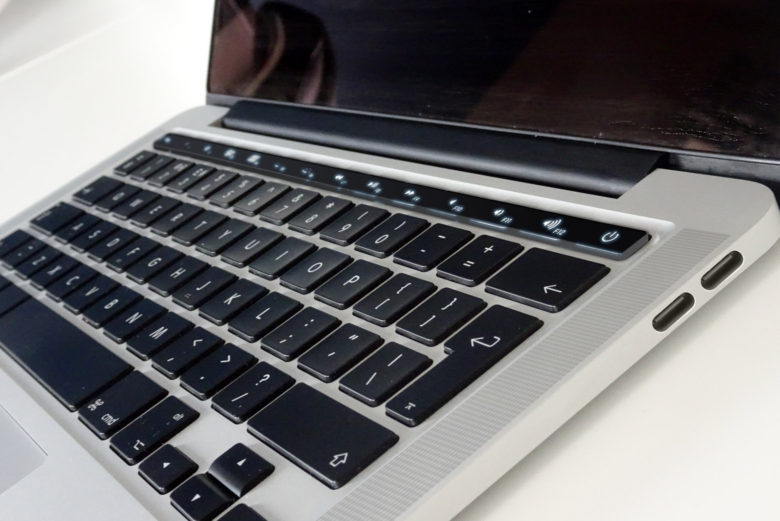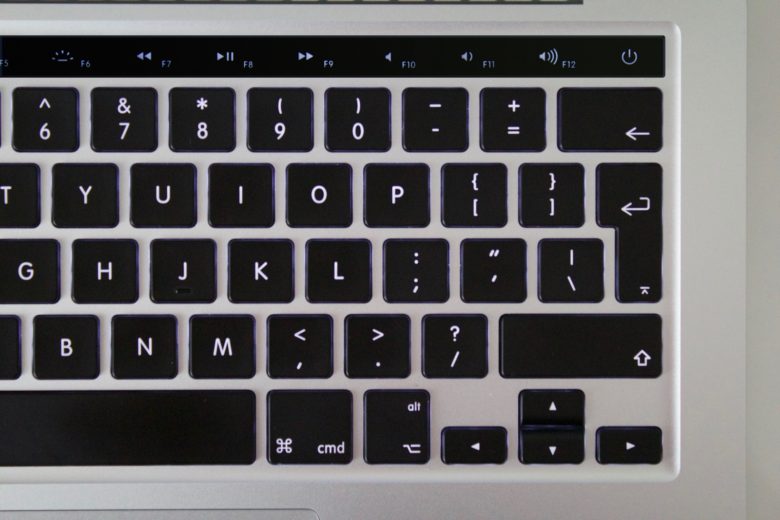Apple’s new MacBook Pro is right around the corner, if recent rumors are to be believed, and it’s shaping up to be one of the most significant refreshes we’ve seen in years. Spy photos all but confirm a new OLED touchbar is coming, but is this advanced hardware really necessary?
 Those who are excited about it can see the how customizable function keys might improve their experience in macOS, while others believe it will be little more than a gimmick.
Those who are excited about it can see the how customizable function keys might improve their experience in macOS, while others believe it will be little more than a gimmick.
Join us in this week’s Friday Night Fight as we discuss whether the MacBook Pro really needs an OLED touchbar.
 Luke Dormehl: In preparation for the new MacBook — which will reportedly feature an OLED touchbar — I was thinking about similar examples we’ve seen elsewhere before. One that sprung to mind was Lenovo’s 2014-era ThinkPad X1 Carbon Ultrabook laptop.
Luke Dormehl: In preparation for the new MacBook — which will reportedly feature an OLED touchbar — I was thinking about similar examples we’ve seen elsewhere before. One that sprung to mind was Lenovo’s 2014-era ThinkPad X1 Carbon Ultrabook laptop.
This computer boasted an Adaptive Keyboard. As with the MacBook Pro’s rumored OLED touchbar, the Lenovo laptop offered a row of function keys that changed according to the program you were using at the time. For example, if you were using a web browser, the adaptive keys would let you refresh pages, go backward, and so on.
It was a neat idea, but it didn’t really work all that well. Users complained that Lenovo fiddled with the keyboard for no reason other than to add a gimmick, and the Adaptive Keyboard never caught on.
Now, I’m not going to write off a technology because Lenovo couldn’t do it. Apple’s a different beast, and — as we’ve seen throughout the company’s history — it possesses an impressive ability to take idea others have carried out in a so-so manner and to execute them flawlessly. I have no doubt that Apple could do the same here, but I just worry that this is a feature people weren’t crying out for. The concept of a keyboard that changes according to your application goes back to Steve Jobs and the original iPhone launch. Remember how he talked about how other phones at the time had keyboards that were “fixed in plastic” and remained “the same for every application”?
The difference is that Apple isn’t replacing the existing keyboard with a new way of doing things. It’s adding another input device, alongside keyboard shortcuts, regular keyboard key entry, on-screen icons and menus operated with the mouse, Siri commands on macOS Sierra, and more. It’s never going to feel perfectly intuitive because you’ll have to continuously look down from your screen to the keyboard to see which buttons are available — unless you memorize an added UI element for every app.
I just don’t see it.
 Killian Bell: Well, I totally disagree. I think an OLED touchbar would be an excellent addition to the MacBook Pro for many reasons — some of which I’ve already written about. I also think it’s time Apple took the keyboard we’ve been using for decades and made it greater in the same way it upgraded the trackpad by adding multitouch and later Force Touch.
Killian Bell: Well, I totally disagree. I think an OLED touchbar would be an excellent addition to the MacBook Pro for many reasons — some of which I’ve already written about. I also think it’s time Apple took the keyboard we’ve been using for decades and made it greater in the same way it upgraded the trackpad by adding multitouch and later Force Touch.
It’s not difficult to see why a similar idea flopped with the ThinkPad X1. Like Android, Windows is incredibly fragmented. With thousands of Windows-powered laptops on sale today, no developer wants to waste resources optimizing software for a feature that’s only available on a handful of machines.
It’s different with the MacBook Pro, which is one of just three notebooks in Apple’s lineup (and soon one of two, when Apple inevitably kills the MacBook Air). Not only will that touchbar be available to more users, making app optimization worthwhile, but we know it will be sticking around for the foreseeable future and will eventually make its way to other Macs.
What’s more, OS X and iOS developers are the best at adapting to new hardware as soon as it’s available. Look at how quickly so many iOS apps received support for RAW photos following the launch of iPhone 7, or how many Mac apps were updated to support the Force Touch trackpad when that made its debut.
The OLED touchbar on the MacBook Pro won’t be a forgotten feature like the Adaptive Keyboard was on the ThinkPad X1. It will be widely supported and will become more useful over time.
 Luke: I realize there’s a world of difference between a feature on one of hundreds of Windows-running laptops and one on Apple’s flagship MacBook. I also have no doubt that Apple will implement the solution beautifully, perhaps folding in the work it’s doing with artificial intelligence and the Taptic Engine, and more.
Luke: I realize there’s a world of difference between a feature on one of hundreds of Windows-running laptops and one on Apple’s flagship MacBook. I also have no doubt that Apple will implement the solution beautifully, perhaps folding in the work it’s doing with artificial intelligence and the Taptic Engine, and more.
What I’m wondering about is whether the OLED touchbar will actually make the MacBook Pro more useful.
It’s not going to be a big part of the way we interact with macOS, because only a small percentage of users are going to be able to use it at first. That’s not necessarily a problem, since Apple has to start the rollout somewhere, but it does mean this is going to be presented as an afterthought on day one, rather than an essential interface element. I guess the bigger point is what it offers that can’t already be done in a variety of other ways — whether through on-screen shortcuts, keyboard shortcuts or whatever else.
We shouldn’t constantly harp on about what Apple did under Steve Jobs, but one of the great things he focused on was simplicity: choosing the best way to do something and offering that as the option. It was the Henry Ford “whatever car you want so long as it’s black” approach to innovation. I just don’t see the need to add another potentially confusing input technology into Macs. If anything, it takes me back to the early “mode”-based days of personal computers.
Do you really see this being something that achieves widespread adoption? Or is it just going to be there every now and then when you remember it? Because I don’t see any purpose in that. It’s an Android flagship approach to innovation: a gimmick that doesn’t fundamentally alter how you use a device.

Photo: Ste Smith/Cult of Mac
 Killian: I don’t think the impact on macOS, or the time it takes for the touchbar to reach other Macs and more users, really matters that much. The most important thing is that developers support it; that’s what will determine whether it’s actually useful or just a gimmick. And we know developers will embrace it in the same way they embraced the other changes I’ve mentioned.
Killian: I don’t think the impact on macOS, or the time it takes for the touchbar to reach other Macs and more users, really matters that much. The most important thing is that developers support it; that’s what will determine whether it’s actually useful or just a gimmick. And we know developers will embrace it in the same way they embraced the other changes I’ve mentioned.
It doesn’t matter that the touchbar might replicate shortcuts we already have. What’s important is that it makes things easier. Why remember a keyboard shortcut for a function in Paintshop or Logic Pro X, which might require three different keys, when you can have a dedicated button? The touchbar could also be used to provide macro keys for our favorite games.
I think Steve Jobs would fully support an OLED touchpad. There’s no reason why it can’t be simple and easy to use. We already use function keys for many things; all the touchpad will do (based on the rumors we’ve seen) is make those function keys customizable so you can tailor them to the apps and shortcuts you use most frequently.
Yes, I do see it achieving widespread adoption. I don’t think it will remain exclusive to the MacBook Pro or that we’ll all forget about it. I think Apple will make it available on other MacBooks and even its standalone Mac keyboards later on, and that developers will embrace it and make it even more useful over time.
 Luke: But what’s the point of offering yet another way to do the same thing? It would be one thing if this was offering new functionality that doesn’t currently exist, but we’re talking about options that are a click of the mouse on the display. Apple could, I grant you, come up with a totally different way to implement this than Lenovo’s approach, but everything we’ve heard suggests it’s going to be along the same lines.
Luke: But what’s the point of offering yet another way to do the same thing? It would be one thing if this was offering new functionality that doesn’t currently exist, but we’re talking about options that are a click of the mouse on the display. Apple could, I grant you, come up with a totally different way to implement this than Lenovo’s approach, but everything we’ve heard suggests it’s going to be along the same lines.
I really hope that it catches on as you suggest, but it sounds like a hardware solution to a problem that doesn’t exist. And that’s never been Apple’s style.

Photo: Ste Smith/Cult of Mac
 Killian: My guess is that Apple’s OLED touchbar won’t just replicate existing functions — it will substantially improve the Mac.
Killian: My guess is that Apple’s OLED touchbar won’t just replicate existing functions — it will substantially improve the Mac.
What’s the point of Apple Pencil when we all have fingers? What’s the point of a touchscreen when smartphones were usable with a physical keyboard? What’s the point of the iPod when portable CD players were perfectly capable of playing our favorite albums on the go?
All these things are improvements over what we already had. Apple is just looking to make the keyboard better and more useful — and an OLED touchbar can do that without making drastic changes that will affect the typing experience.
We’re clearly not going to agree on this, so let’s hand it over to the readers. Do you think adding an OLED touchbar to the MacBook Pro is worthwhile, or do you think it will be little more than a gimmick that only a small percentage of people will actually use?
Friday Night Fights is a series of weekly death matches between two no-mercy brawlers who will fight to the death — or at least agree to disagree — about which is better: Apple or Google, iOS or Android?
![Does the new MacBook Pro need an OLED touchbar? [Friday Night Fights] fnf1b](https://www.cultofmac.com/wp-content/uploads/2016/10/fnf1b.jpg)

